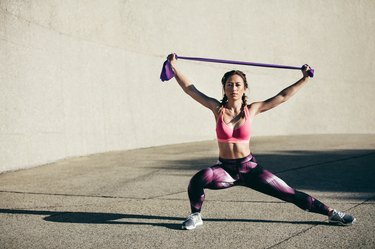
When you perform an exercise, your muscles go through a series of contractions called concentric, eccentric and isometric contractions.
Isometric contraction happens when the muscle is activated and held at a constant length without changing the position of the nearby joint(s), according to the University of California San Diego. Muscles lengthen during eccentric contraction and shorten during concentric contraction.
Video of the Day
It's important to move your muscles in all three motions, but focusing on isometric movements can help improve your stabilization because your muscles contract to hold you in place, according to the Mayo Clinic. In a plank (an isometric core exercise), for instance, you're contracting your abs, quads and glutes to keep your body in a straight line.
While there are plenty of ways to incorporate isometrics into your workout routine, the Bullworker is a versatile tool that can help you get more out of your isometric holds and improve your range of motion without putting additional pressure on your joints, like lifting weights.
What Is the Bullworker?
The Bullworker is an exercise tool that uses isometric principles to help strengthen your muscles. The Bullworker looks like a bow with two resistance bands on either side of the spring-loaded handle.
The Bullworker comes in three different ranges of resistance: The Bullworker Basic has the lowest set of resistance and comes with five different sets of springs that you can build the resistance to up to 75 pounds.
The Steel Bow also comes with five interchangeable springs, but it provides a wider range of resistance of up to 130 pounds. The Bow Classic offers the heaviest resistance with up to 160 pounds and is known as the "barbell" of the Bullworker products because you can use it to do heavy, explosive lifts.
If you are new to the tool, Bullworker recommends starting with the lowest resistance, which is the Bullworker Basic. As you get stronger, you can install a heavier resistance spring and advance with the Steel Bow and Bow Classic.
Bullworker Exercise Benefits
You can use the Bullworker to perform a variety of isometric holds for common exercises, including lat pull-downs, deadlifts and calf extensions, by pausing when you feel the most tension in your muscles.
For example, when performing an upright row with the Bullworker, you would come to a half-kneeling position and secure the bottom band with one foot. Then, you pull the top band with both hands towards your shoulders. You can pause at this position for an isometric hold.
Bullworker recommends holding an isometric exercise for 7 to 10 seconds at 60 percent to 80 percent of your max effort. So if your max biceps curl is 30 pounds, you would adjust the resistance of your Bullworker Basic to do an isometric hold at 18 to 24 pounds.
While a lot of the burn from the Bullworker will come from isometric movements, it also allows you to do isotonic exercises, which involve contracting the muscle while moving one or more joints. That's just a fancy way of saying you can use the Bullworker to perform squats, reverse lunges and overhead shoulder presses with full range of motion, so you'll get the benefits of concentric and eccentric contractions, too.
Because the Bullworker offers different ranges of resistance, it can be used to practice the principle of progressive overload. As you get stronger, your muscles begin to adapt to the strain of the resistance, so it's important to increase the load, volume and tempo of an exercise to make it more challenging.
Just like a resistance band, the Bullworker creates tension throughout an exercise, so it can be used to enhance eccentric loading by forcing you to move slowly through the downward phase. In a biceps curl, the eccentric phase is lowering the weight. By increasing the time your muscle is under tension, it makes it stronger.
Regardless of age or fitness level, just about anyone can benefit from using resistance equipment, like the Bullworker. The Bullworker is also light and compact, so you can pack it for travel and do a workout with it anywhere.
To learn more about how to use the Bullworker and get the most out of your workouts, check out their extensive library of exercise images and videos. Plus, check out the video below for a sample Bullworker workout you can do at home.